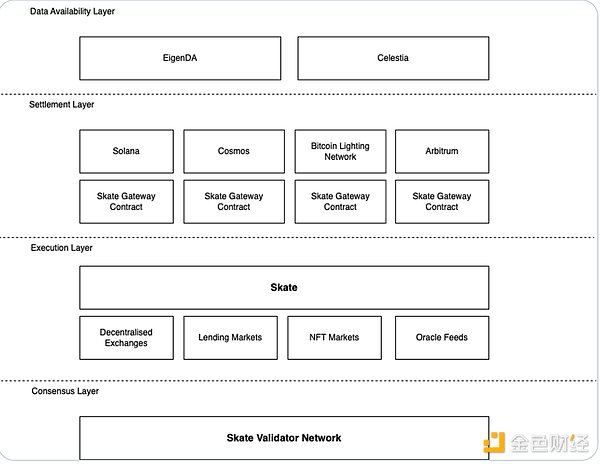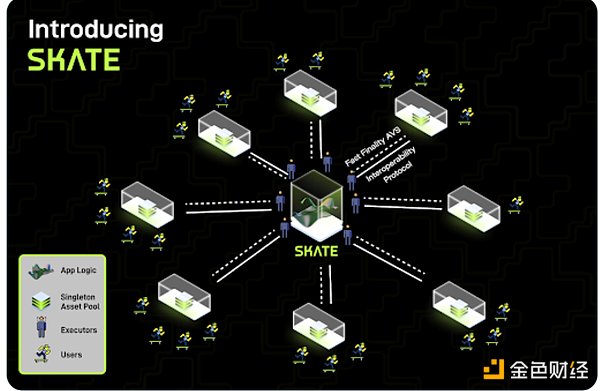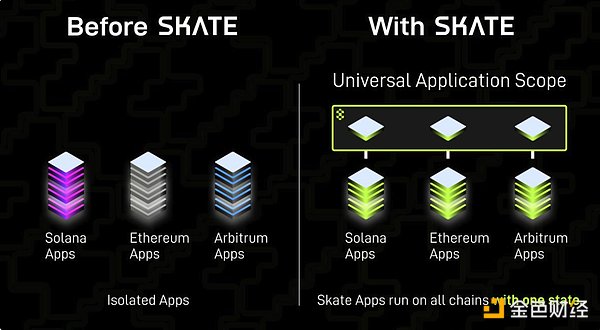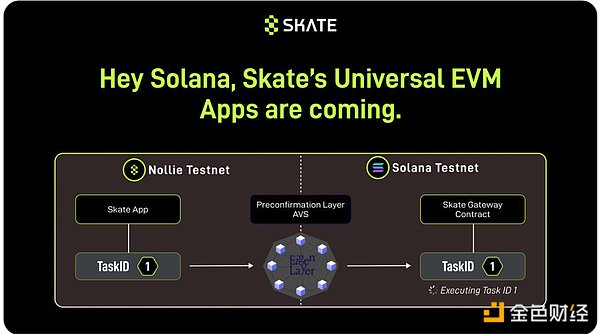Author: zerokn0wledge, Redacted Research Co-founder Source: X, @zerokn0wledge_ Translation: Shan Ouba, Golden Finance
We are moving towards a Rollup-centric future, a complete ecosystem consisting of vertical or application-specific execution layers. Modularity has accelerated this process, making the rise of thousands of customizable blockchain technology stacks possible. However, while modularity has brought unprecedented scalability and more powerful network design, it has also brought inherent fragmentation of liquidity and users across the ecosystem.
This is a big problem for user experience. To solve this fragmentation, we need unified and chain-independent execution, allowing general applications to be deployed on any chain, regardless of the consensus mechanism it runs, the virtual machine, or the programming language it supports. Sounds too ideal? In fact, Skate makes this a reality. Universal state driven by cross-chain intent and Eigenlayer.
Let's take a look at how it works.
Skate is a novel infrastructure that fits seamlessly into the modular stack. It sits on top of the execution layer and couples it with cross-chain intent verification through a proprietary Eigenlayer-based consensus mechanism.

Skate itself is an optimistic Rollup based on the OP Stack implementation, currently running on the Nollie testnet. Initially, a centralized sorter will sort transactions before they are finalized on the Ethereum mainnet. However, Skate aims to increase decentralization by moving to a network of sorter nodes or integrating a scalable decentralized sorter like EspressoSys.
The Skate validator network consists of independent lightweight validator nodes, and its underlying BFT* (Byzantine Fault Tolerant) consensus is based on Eigenlayer. Byzantine Fault Tolerance is a property of computer systems that makes the consensus mechanism resistant to certain types of failures even in the presence of malicious actors. This means that even if some nodes are down or behave badly, we can still reach consensus through BFT. As long as 2/3 of the nodes act honestly, the network is secure.
In order to become a validator of Eigenlayer, participants need to lock up a certain amount of tokens as collateral. If any malicious behavior is detected, these tokens will be slashed to maintain the integrity of the network.
Skate's AVS is mainly used as a chain-agnostic fast finality layer (FNN). It facilitates access to the state of the Skate central hub chain through a pull-based request system.

This is because transactions are executed by users signing "intents" (i.e. orders) between networks, which requires the "executors" who handle these intents to be able to see the state of each network.
Let's look at an example.
Imagine you want to transfer $1,000 from Ethereum to Solana. If such a request is made, the executor needs to confirm that these assets exist on Ethereum (the source chain) and have been successfully transferred to Solana (the target chain).
Therefore, Skate ensures fast finality by leveraging a decentralized @EigenLayer network of nodes based on cryptoeconomic security to pull state from different sources.
To achieve this, validators run specialized software and indexers to collect and prepare the required data.
When a request is made, the AVS validator creates executable calldata that encodes the necessary function call and parameters to be executed against the state of the settlement chain. This process enables the settlement chain to mirror the current state of the hub chain.
The main responsibility of AVS is to create a set of instructions called "calldata" for a given task. This calldata contains the specific function call and parameters that must be executed on another blockchain. Cool, right? But that's not all.
Skate is more than just an ordinary bridge, its capabilities go far beyond simple asset transfers. Skate allows universal (EVM) applications to run on any chain.

Recently, Skate expanded to Solana, successfully executing taskIDs from the Skate Nollie testnet onto Solana's testnet through EigenLayer pre-confirmation AVS. This means that EVM applications can not only run on Solana, but can also be synchronized with the common state of the unified 1,000 chains, paving the way for broad and secure interoperability.

Don't build isolated applications anymore. Build applications with universal state across chains.
 Kikyo
Kikyo








